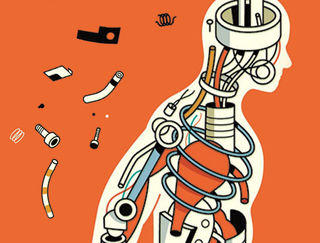Beauty
The Beauty of Human Imperfection
Our flaws show how our past shaped our present.
Posted November 12, 2018
I’ve been thinking a lot about design and imperfection lately.
Somewhere in the fog of that reflection, I found myself on the main stage of the Ars Electronica Festival, a truly global exhibition of digital art. This annual showcase in Linz, Austria has seen the premier of some of the world’s most provocative and innovative electronic art for nearly 40 years. Why was a biologist speaking at a digital art festival? This year the theme was Error: The Art of Imperfection and I guess I am becoming a go-to guy for a talk on human flaws.

Nevertheless, in all my research on defects in the human body, I never once thought about them as artful. Where is the art in achy backs, junky DNA, and high infant mortality? However, surrounded by stunning works of art and brilliant artists and scholars, the inherent beauty of our very human flaws suddenly struck me. Beauty is often understood as an expression of perfection, but this thinking is all wrong: It is imperfection that leads to beauty.
The opening lines of the conference program discussed the typical process of making mistakes while working on an art project. How do we know if it is an error or an innovation? Is it a goof-up to be corrected or the beginning of something great? Although this was meant to be read in the context of art and design, it is also a poetic way to think about the root of all innovation in living systems: Mutations.
Mutations in genetic material most often begin as DNA copying errors, mistakes in the purest sense. Because they are purely random, these mistakes are often bad, and even more often neutral. But occasionally, very rarely in fact, a mutation comes along that gives new function, new meaning, to a gene. These extraordinary mutations are the raw material of all of the great diversity of the living world, of everything that moves and breathes and gives birth to new life.
From the simplest microbes to the towering redwoods, it all began with a mistake. And then another. And then another. Out of this swarming chaos emerged everything that lives, including us, not unlike the majestic Grand Canyon that sprang forth from nothing more than rock, water, and whole lot of time.
Homo sapiens has a very long history and because we weren’t writing things down until recently, we have to work very hard and very creatively to piece that history together. Fortunately, modern science has developed a variety of clever tools that help us discover our past and begin to make sense of it. There is great value in understanding the forces that shaped us into the wonderful and flawed species that we are. By better understanding our past, we better understand ourselves.
Often, we think of fossils when we consider our biological past. Fossils are indeed crucial for tracing our evolutionary history and the anatomy, physiology, and even behavior of our forebears. However, lucky for us, we can also gain insights by examining our bodies as they are right now because we bear the scars of our past selves. Our diseases are like echoes of ancient battles. Our genomes hide the carnage of vanquished viral foes. Even the quirks of the human mind reveal something about the world in which we once lived. Some of our idiosyncrasies are actually anachronisms, like windows into our distant past.

One exciting way to make sense of the human animal, the most unlikely of creatures, is through scrutinizing our shortcomings. While the human body is indeed a marvel, it is far from perfect. For example, we have nasal sinuses that drain upward, genes that don’t work, nerves that take bizarre paths, and muscles that attach to nothing. While these can fairly be called flaws, they are not flukes and, in most cases, they do not defy explanation. Rather, our many glitches hide fascinating tales of the lives our ancestors once lived. Ours is a history of triumph against all odds.
But, you might ask, how could these flaws have come about? Yes, mutations are random and often harmful, but isn’t it the job of natural selection to weed out those mistakes and march us toward perfection? Unfortunately not. As our many human errors make clear, evolution is clumsy, aimless, and utterly indifferent. We are not evolved to be healthy or happy or comfortable. We have evolved only to survive and reproduce. Evolution is a game of cruel compromises and sloppy trade-offs. What more can we expect from a process that works through the randomness of mutations?
Consider the demands of the human diet. We require a wide variety of foods in order to be healthy, far more so than other animals, who can often subsist on just one or two foods their entire lives. This is partly because, for most of our history, we were living in a veritable salad bowl, surrounded by a cornucopia of nutritious food. We then supplemented that with foraging behaviors, adding even more variety. In the process, we lost the ability to make many vitamins and other nutrients for ourselves. Our dietary need for vitamins C, D, and B12 each reveal a different kind of flaw in our metabolism.
Far worse even than that, the main staple foods throughout world cultures are derived from plants intentionally cultivated and shaped by our ancestors. These plants are starchy crops that our bodies are not well suited to subsist on. While it would be unfair to pin this imperfection on evolution, because, in a sense, we did this to ourselves, it does show the limits of our biology and the way in which our past shapes our present.
The one thing that you might think we have mastered, given how global our proliferation has been, is reproduction. But, in fact, a shocking number of us struggle with infertility. This is no surprise when you consider that our ovaries are not secured to our fallopian tubes, our sperm cells cannot turn left, and our embryos frequently end up with the wrong number of chromosomes. Before modern medicine, it was shockingly common for the mother or the baby, or both, to die during childbirth or soon thereafter. This is a fate very rarely suffered by our fellow apes. Of course, the tension between our enormous skulls and narrow pelvises is mostly to blame, but many other things can go wrong with our reproduction as well. It’s a wonder we’ve made it this far.
But we have made it this far. Our flaws also speak to our greatness. Part of why we have so many glitches is that we are very good at getting around them. By evolving a big brain, we took the pressure off our body to be perfect. Using our body alone, we could never live in climates from the Sahara to Antarctica, but by using our brain, we can thrive almost anywhere. From the hand axe to the smart phone, we have a long history of using technology to augment the limits of our bodies.
If pressed to take an opinion on whether humans have more physical and genetic flaws than other animals, I would have to answer in the affirmative. We really do seem glitchier than our animal cousins. This is more good news. Only a species with a social structure as tightly woven as ours could ever have survived with bodies this limited. If your eyesight is no good for hunting, perhaps you can be a homesteader. If you are too sickly for child rearing, maybe you can craft tools or clothing. If your body is too worn or crippled, your wisdom or cleverness is still of great value to your people. We descend from a long line of not just hunters and gathers, but shamans and seamstresses, nannies and tradesmen, artisans and bureaucrats. Our ancestors were dreamers and planners, and who would want it any other way?
Rather than doom and gloom, a full accounting of our glitches and limitations provides clues on how to live in better harmony with a body that was shaped for a very different world. Despite our many flaws, we have accomplished so much that is worth fighting for. Expecting our bodies or minds to be perfect is not reasonable, but fortunately, evolution’s standards are much lower than that. All we must do to continue to thrive is to learn from our mistakes. But before we can learn from them, we must acknowledge them. Personally, I go further than that. I celebrate them.
Of all the species that have ever walked the earth, we may be the most flawed, but we are certainly the most beautiful.
References
Lents NH. Human Errors: A Panorama of our Glitches, from Pointless Bones to Broken Genes. New York: Houghton Mifflin Harcourt. 01 May 2018.




